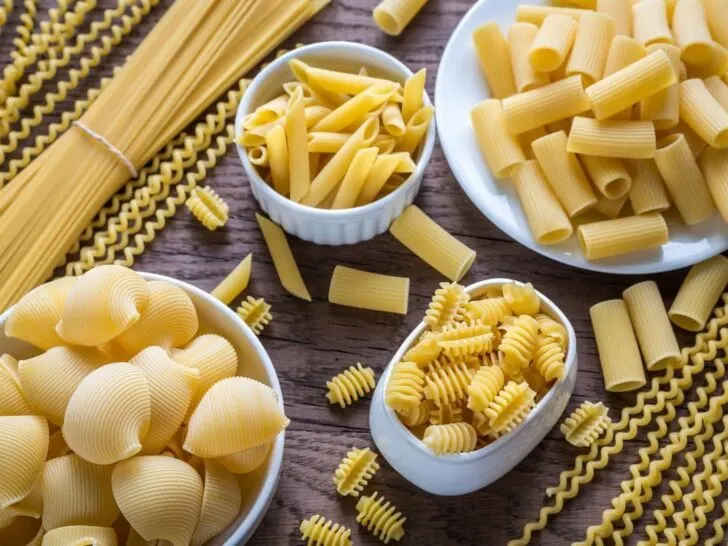One of the top comfort food dishes, ragù alla Bolognese, or simply ragù, is an authentic Italian sauce originated in the city of Bologna, the capital of the Emilia-Romagna region, which, according to most locals, is a top foodie destination in the country.
This article brings you a delicious ragù Bolognese recipe plus everything you need to know about the most popular pasta sauce in Italy.
Jump To Sections In This Article:
Origins of Ragu Bolognese
Although many Italians would argue that the Bolognese ragù comes, as its name suggests, from the city of Bologna, the truth is that the origins of this sauce are not as straightforward.
According to different sources, several sauces made from meat were already present in the Roman Empire, yet we can imagine that the taste would have been quite different.
The second most important ingredient needed to cook the sauce, the tomato, will have to wait a few more hundred years to make its way into Europe after the first Conquistadores brought it back from the Americas.
Other sources like to place the origins of this very Italian dish in the France of Louis XIV. It is said that his main chef, who was in fact from the city of Bologna, was the first one to think about grinding the remains of a rich meat stew and then serving on top of pasta.
What is certain is that the word ragù has French origins. It comes from the word ragoût, a term that would describe any meat (including fish as well) cut into very small pieces with the aid of a sharp knife (meat grinders were not yet invented) to then add to a rich sauce with plenty of vegetables or some kind of stew and cook for long hours over low heat.
Curious fact: the French word “ragoûter” means stewing over low heat.
During the Renaissance, ragù alla Bolognese was one of the favorite dishes among Italian aristocrats as the meat was too expensive to be affordable for lower-class families.
Today, instead, it is considered among the most convenient dishes (and most affordable ones at any restaurant), as well as a dish that finds enthusiasts among locals and travelers alike, from all ages (especially kids), since it is really simple and made with few ingredients.

Different Meats – Different Ragù
The base of the ragù sauce is minced, ground, or even chopped meat, often beef mutton or veal, but also chicken, pork, duck, and lamb can be used, and many times the sauce uses the combination of two different meats, such as beef and pork.
The sauce also needs a liquid medium, often tomato sauce but also broth, stock, wine, and water (often more than two of these are combined too).
In the traditional Bolognese ragù, the meat used is generally beef, and the quantity of tomato or tomato sauce will never be larger than the quantity of meat, as Bolognese is often a fairly dry sauce.
Another curious fact about the Bolognese version of ragù is that the base of the tomato sauce is made of just three ingredients: onions, carrots, and celery.
Ragù alla Bolognese should never include aromas, so you won’t find any parsley, rosemary, garlic, oregano, chili, nutmeg, or bay leave. Even if each Italian family has its own version that may include different herbs.

Tagliatelle al ragu in Bologna Italy
Varieties of Ragu in Italy
Even when the most common ragù sauce you will find in Italy is made either from veal or from a blend of minced beef and pork, there are many ragù varieties, both in Italy and abroad, to make this incredibly versatile sauce.
Some of the most famous varieties include ragù alla Barese (from the Bari area of Italy), which is made with horse meat, while ragù alla Veneta (from the Veneto region) is made with no tomatoes and duck meat. Another popular version includes fried pancetta in the meat mixture, not so traditional but really delicious.
Ragù di cinghiale, or wild boar ragù, is often cooked in the regions of Tuscany, Umbria, and Marche, places where game is common. This ragù variety is cooked with abundant red wine (in fact, the meat is marinated in red wine for at least twelve hours) and sometimes includes olives.

Tagliatelle al ragu with wild boar in Florence Italy
Ragù alla Napoletana is a ragù variety often cooked in Naples and in other southern regions of Italy that includes whole cuts of beef and pork as well as rustic sausages or small meatballs.
In most traditional households, the pasta is served as the first dish with just the tomato sauce, while the chunks of meat are served as a second dish after the pasta.
Ragù of vegetables is a vegetarian version of the sauce, which is made with small cubes of different vegetables and which might also include diced mushrooms.
Rabbit ragù is another less common but equally delicious sauce used to accompany pasta, mostly in the northern regions of Italy.
Finally, a lesser-known version is ragù in bianco, or white ragù, a traditional variety that does not include tomatoes.
Other Uses of Ragù
This super versatile meat sauce is perfect to accompany any kind of pasta, mostly long pasta such as pappardelle or tagliatelle.
Yet, ragù is also useful as the base of another traditional pasta dish, lasagna, and delicious on top of polenta, another typical Italian delicacy, often eaten in the Lombardy and Veneto regions.
For a twist, use it to make your Greek moussaka; just add a pinch of cinnamon for it to have the most authentic Greek taste!
RELATED: Best Foods to Eat in Greece
Tips for Making Ragù alla Bolognese
If you’re wondering how to prepare the original version of this sauce, the same one that the Italian Academy of Cuisine deposited at the Bologna Chamber of Commerce, relax.
This is a simple preparation that just requires you to have enough available time to follow the cooking procedure, respecting with precision the different parts of the recipe, especially the one that calls for slow and patient cooking times. That’s the true secret to a delicious result!
What Meat to Use
When choosing the meat, select a ground meat that is not too lean (it can be either beef or a combination of beef and pork) that you will need to pair with a full-bodied, good-quality tomato puree (without any added herbs or seasoning).
Which Pasta is Best with Ragu
Now, you will also need to choose the type of pasta you prefer among tagliatelle, pappardelle, or spaghetti, but you can also choose orecchiette, penne, gnocchi, or lasagna for a baked version.
Another important thing to know is that you can even freeze the sauce in small portions to use in the weeks to come (I often save time cooking a large batch of ragu, which I then place in small containers that hold enough to season a kilo of pasta each).

Do’s and Don’ts of Ragù
Even when it is quite common (in several countries) to serve ragù alla Bolognese with spaghetti, Italians disagree with this!
Why? Well, most chefs agree that this kind of sauce needs a rustic type of pasta (better if trafilata al bronzo, or bronze-drawn pasta) with a textured surface to better “grab and hold” the juices.
And remember, don’t call it pasta alla Bolognese. In Italy, unlike other countries, you will find written on menus “al ragù”, so look for “tagliatelle al ragù” or “pappardelle al ragù” to find a pasta dish seasoned with Bolognese ragù.
Seasoning is not allowed; any Italian would argue and swear that authentic ragù should never include strong tastes such as garlic or rosemary, as they might alter the taste of tomatoes. However, salt, pepper, nutmeg, and sometimes bay leaves are permissible.
Traditional Ragù alla Bolognese Recipe
- Preparation time: 15 minutes
- Cooking time: 3 hours
- Servings: 6
When you make the ragu be sure to allow yourself enough time to let the sauce cook slowly. Relax, don’t rush it.
Ingredients
For six people you will need:
- 1 lb (450 g) ground beef (not too lean)
- .5 lb (225 g) ground pork (not too lean)
- 20 oz (500 ml) tomato puree (and water)
- 1 small onion finely chopped
- 1/3 cup (70 g) finely chopped celery
- 1/3 cup (70 g) finely chopped carrot
- Extra virgin olive oil
- Salt and pepper
- 100 ml white wine
Directions
- Start by peeling, washing, and chopping the vegetables; try to chop the carrots, onion, and celery into very small pieces.
- Add three or four spoonfuls of extra virgin olive oil to a tall steel pot and heat on low flame for a few minutes. Add the vegetables and sauté until the onion becomes transparent. Season with salt and pepper.
If you want to get away from the original recipe and add a bay leaf or any other herb, this is the best time to do so.
- Then, add the ground meat and crumble it using a wooden spoon. Let the mixture get an attractive brownish color (about 10 more minutes in moderate heat) so that the meat juices evaporate almost completely.
This is the right time to add the wine and turn up the flame to make it evaporate completely.
Important tip: Even when you would think that a glass of good red wine is the best for this sauce, many chefs prefer to use white wine to interfere less with the taste of the meat.
- Once there is no trace of alcohol in the sauce, add the tomato puree and one glass of water.
- At this point, reduce the flame to the minimum and cover the pan. Let it cook at a very low temperature for three hours. Open the lid from time to time, and gradually add another glass of water two or three times.
- At the end of cooking, adjust the seasoning, and if you really want to respect the ancient version of the recipe, you can also add 50 ml (1.75 oz) of milk, which helps dampen the taste of the tomato. If your sauce results in a dry but creamy compound, then your Bolognese sauce is ready!
- Cook your pasta of choice; pappardelle or tagliatelle are two of the best pastas to have with ragu alla Bolognese. Serve with grated Parmigiano Reggiano and a glass of wine. Enjoy!
Storing Leftover Ragu
If you want to keep some of the sauce, or if you live on your own and a recipe for six is too much, you will be happy to know that ragù can be perfectly well kept in the fridge for 3 to 4 days inside an airtight container.
Freezing the sauce is also possible. I suggest using practical single portions (ziplock bags work wonders) so that there is always a batch of delicious ragù ready whenever you feel like it. You can defrost it and use it with any variety of pasta you prefer.
Save this to Pinterest for later!

More Italian Foods to Try
Authentic Carbonara (Easy Recipe)
15 Best Italian Desserts to Try
More Recipe Ideas
15 Delicious Low Carb Dessert Recipes
18 Yummy Low Carb Breakfast Recipes
15 Tasty Tantalizing Texas Recipes
18 Delicious Meat Taco Recipe Ideas
12 Nutritious & Delicious Vegetarian Taco Recipes
10 Scrumptious Seafood Taco Recipes Perfect For Taco Night
About the Author

Gabi Ancarola is a translator and travel journalist living in Crete. She regularly writes about Europe for several magazines about travel, gastronomy, and hospitality. She has published several travel guides about Greece and plans customized trips to the Greek islands. She loves cooking local dishes, taking photos, and driving on the mountain roads of Crete.
